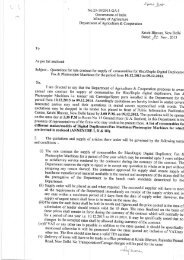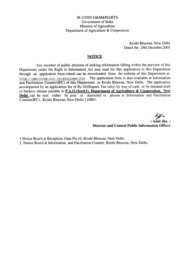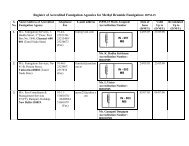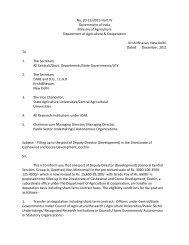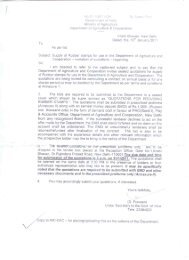canopy management in fruit crops - Department of Agriculture & Co ...
canopy management in fruit crops - Department of Agriculture & Co ...
canopy management in fruit crops - Department of Agriculture & Co ...
You also want an ePaper? Increase the reach of your titles
YUMPU automatically turns print PDFs into web optimized ePapers that Google loves.
shapes and sizes, and cont<strong>in</strong>ued as trees mature. In commercial orchards,<br />
prun<strong>in</strong>g facilitates normal daily operations. Where trees have outgrown<br />
their allotted space, prun<strong>in</strong>g can <strong>in</strong>crease the bear<strong>in</strong>g surface. Trees that<br />
grow too close together shade out the lower <strong>canopy</strong> portions and <strong>in</strong> turn<br />
decrease their <strong>fruit</strong> sett<strong>in</strong>g. When pruned to allow light to reach the top<br />
and lower sides <strong>of</strong> trees, the <strong>in</strong>creased bear<strong>in</strong>g surface results <strong>in</strong> more <strong>fruit</strong><br />
sett<strong>in</strong>g. Any sprouts aris<strong>in</strong>g from the rootstock (i.e. from below the graft<br />
union) should be removed. Prun<strong>in</strong>g <strong>of</strong> the scion <strong>of</strong> young trees only delays<br />
growth and extends the juvenility. Prun<strong>in</strong>g is done either to encourage the<br />
growth (th<strong>in</strong>n<strong>in</strong>g) or to reduce the tree size (head<strong>in</strong>g back). Th<strong>in</strong>n<strong>in</strong>g <strong>of</strong><br />
bear<strong>in</strong>g trees encourages vegetative growth, and removes <strong>in</strong>terior branches,<br />
encourag<strong>in</strong>g the outward growth <strong>in</strong>to the allotted area planned for mature<br />
trees to occupy. Head<strong>in</strong>g back reduces the outward <strong>canopy</strong> growth through<br />
topp<strong>in</strong>g and hedg<strong>in</strong>g <strong>of</strong> branches.<br />
2<br />
To fulfil the nutritional demand <strong>of</strong> burgeon<strong>in</strong>g population <strong>in</strong> the country<br />
and to meet the global challenge <strong>in</strong> the <strong>in</strong>ternational market, it is need <strong>of</strong><br />
the hour to accommodate almost 10 times more plants per unit area. This<br />
is only possible with the <strong>management</strong> <strong>of</strong> <strong>canopy</strong> to <strong>in</strong>tercept maximum<br />
light <strong>in</strong> the <strong>in</strong>nermost parts <strong>of</strong> trees. The <strong>canopy</strong> <strong>management</strong> has direct<br />
correlation with dry matter production, flower bud <strong>in</strong>itiation and <strong>fruit</strong><br />
quality.<br />
In this manual, prun<strong>in</strong>g has been dealt with <strong>in</strong> detail, especially <strong>in</strong> respect<br />
<strong>of</strong> its requirement for <strong>in</strong>dividual <strong>fruit</strong> trees. The objectives, pr<strong>in</strong>ciples and<br />
economics <strong>of</strong> prun<strong>in</strong>g <strong>of</strong> various <strong>fruit</strong> trees have been comprehensively<br />
expla<strong>in</strong>ed with practical examples and h<strong>in</strong>ts to meet the requirements <strong>of</strong><br />
farmers engaged <strong>in</strong> production <strong>of</strong> a variety <strong>of</strong> <strong>fruit</strong>s <strong>in</strong> the country.<br />
Canopy Management <strong>in</strong> Fruit Crops



